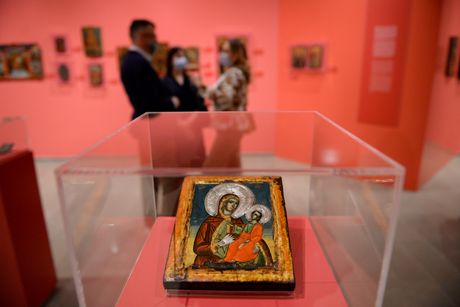National Museum in Belgrade marks 177th anniversary with unique exhibition of icons of Greek masters
The largest influx of Greek icons to the National Museum took place in the decades between 1955 and 1975, when Belgrade was a key point for migration of the population from the southeastern and the western parts of Yugoslavia

In honor of the Day of the National Museum in Belgrade, the 177th anniversary of the founding of this oldest museum institution in Serbia, May 10, was marked by the opening of an exhibition called, "Under the Golden and Blue Sky. 15th-19th Century Icons of Greek Masters at the National Museum." The exhibition showcases professional and scientific work of the curators from the Department for the Middle Ages and work on conservation and restoration, as well as achievements in the presentation of cultural goods.
As part of the selection made by the author of the exhibition, museum advisor Branka Ivanic, 147 icons have been included. Compared to Serbian and Russian icons in the Collection of Post-Byzantine Art of the New Century of the National Museum, the icons created by Greek painters are not only the most numerous, but achievements of great artistic value are recognized among the greatest number of them. These are icons by authors from the territories of traditional Greek lands, as well as from the wider area within the former Ottoman Empire and neighboring countries where influences of Greek culture remained recognizable.
Visitors will have the opportunity to get to know the works of a specific Italo-Cretan icon-painting style, current between the 15th and 18th centuries in the area of the eastern Mediterranean and the Adriatic, and created at the meeting point of Christianity's Orthodox and Catholic influences. Some of the exhibited icons come from the workshops or from the templates of famous Cretan painters such as Andrea Rico, Nicholaos Tzafouris, and others.
The second group of Greek icons in the Museum's collection was created outside the direct influence of the Italo-Cretan painting, in the continental areas of the Balkans, then under Turkish rule. They show the links with the works of the long-lasting and important Kastoria school, whose achievements represent a not negligible share of the total preserved painting heritage of the Balkans of the Turkish era. A special group consists of icons from the Holy Land.
The icon was an unavoidable everyday life item in the Orthodox world. An inalienable part of the icon is the signature, the name of the saint or the composition. The holy person is communicating their thoughts and messages directly and in real time to the observer through text, most often written on a scroll held in their hands. Referring to the same concept, the text and the image together make the icon alive in the spirit of the one who observes it, the moment they observe it. In Byzantine theology, the veneration of icons enabled the pious to have a direct connection with the divine, teaching that the honoring of the painting is transferred to its prototype.
The largest influx of Greek icons to the National Museum took place in the decades between 1955 and 1975, when Belgrade was a key point for migration of the population from the southeastern and the western parts of Yugoslavia. Thanks to these acquisitions taking place over many years, it was possible to form a whole that depicts artistic events from the past related to respecting and spreading Greek icons, those persistent heirs of the Byzantine culture, among the Serbs.
(Telegraf.rs)
Telegraf.rs zadržava sva prava nad sadržajem. Za preuzimanje sadržaja pogledajte uputstva na stranici Uslovi korišćenja.




